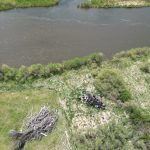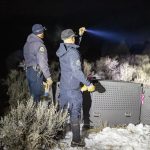Roots of Racing series: Becoming the voice of the Tour
Special to the Daily

Special to the Daily |
This winter, Vail and Beaver Creek hosted the FIS Alpine World Ski Championships for a third time. The Colorado Ski & Snowboard Museum has opened its ski racing archives to tell stories that connect the dots between today’s spectacular made-for-TV competitions and their humble beginnings. This series will feature many of the significant milestones, instigated here in Colorado by individuals now enshrined in the Hall of Fame, which helped shape skiing and international racing. When you are in Vail Village, stop by the museum for a trip through skiing’s past. For more information, go to http://www.skimuseum.net.
In 1977, I was a 24-year-old reporter for Aspen’s KSPN radio, working 24/7 (minus powder mornings) down in the basement of the Hotel Jerome. For two years, I covered the usual town beats, from police to the planning and zoning commission. On weekends, I anchored live radio coverage of World Pro Skiing for the Winter Sports Network, created by KSPN owner Steve Heater, broadcast to a dozen stations in ski towns from Mammoth, California to Stowe, Vermont.
It was late April, after the lifts shut down that I received a call from the founder of WPS, Bob Beattie. My two seasons covering the tour led to an enjoyable relationship with “The Coach,” a legend in the sport of ski racing. Beats, as he is known, wanted to know my interest in taking over the public relations role for his World Wide Ski Corporation. That meant doing PR for both the World Pro Skiing Tour and NASTAR. Plus, I would become “The Voice” of WPS. In the spirit of the tour, it took me one one-thousandth-of-a-second to reply.
“OK, let’s meet this evening at the Jerome Bar and talk it over,” said Beattie.
Where else? Beats had held court at the window end of the bar for decades and camped in front of its door on the Fourth of July for countless parades.

Support Local Journalism
We took the table across from the bar, just north of the archway. I couldn’t believe I was on a job interview with Beats in the Jerome Bar. Very cool.
I quickly learned that Beats’ philosophy was focused on increasing the popularity of ski racing as a spectator sport. That required ways to entice television coverage, which in turn attracted necessary sponsors to keep the circus moving.
“It’s all about entertainment,” Beattie explained
Sure, we leveraged the unique personalities that fled their national ski teams to turn professional. Most important was the medium. Our message was clear: short sprints of head-to-head racing on parallel courses, reducing costs and challenges to ski areas and television networks, while creating a more entertaining environment. This package made it possible to bring races to the people, holding events in Boston, Montreal and other cities. Races in all disciplines were to be run according to a bracket-system in which the race is decided on the final descent.
It was during that three-hour, multiple cocktail interview that on the back of a Jerome napkin, Beats scratched out his vision for a pro race downhill format. Never before had it been attempted, but Bob was determined to figure out how to weave this crowd-thrilling event into his tour, and in a more entertaining fashion than on the World Cup (which Bob had helped create as an amateur circuit in the ’60s). He wanted to make it easier, and thereby more attractive for ski areas to host downhill races. That was going to be done by making them shorter, similar to how the Pro slalom and GS formats made it better for ski resort hosts. The two run format, with only the top 16 qualifying for the second run, meant the race would be decided once again on the final run.
That inaugural downhill happened in December 1977 on Tiehack’s Racer’s Edge at Buttermilk, where an Austrian rookie, Andre Arnold won. Arnold went on to capture the WPS Championship Crown that year and following three years.
“We need more television coverage,” said Beattie during that Jerome Bar interview. He then revealed his idea of collaborating with fellow Aspenite John Denver. Together, our organizations created the remarkably successful John Denver Celebrity Ski Tournaments, an easy sell to network television. Naturally, it included pro race competition within the coverage. It became our tour’s ultimate example of how entertainment can blend with ski racing to build a bigger fan following.
Oh yeah, I took the job. Those next four years running the pro tour, and a decade working with Beats on the John Denver Celebrity Ski Tournaments shaped much of my life. And that’s not to mention the infinite stories those years generated, leading the troupe of swashbuckling pro skiers around the world.










